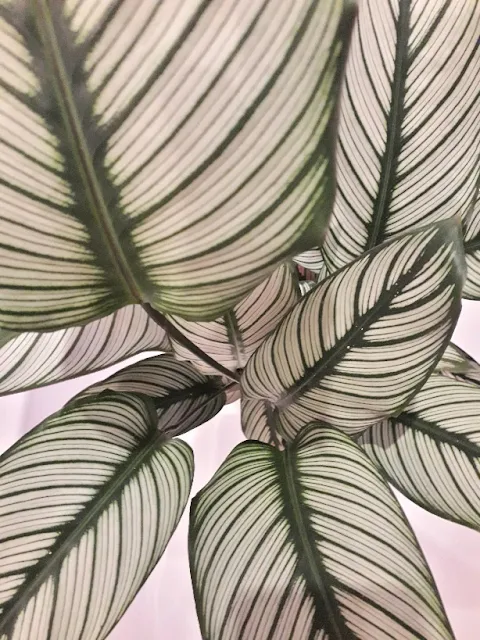There are over 60 species with variegated leaves in shades of pink, orange, red, white and purple. They produce yellow, purple or white blooms in summer.
Calatheas come from the deep rainforests of the Amazon where there is heavy shade and high humidity and temperature. They thrive in very little light and are one of the best indoor plants.
 |
| Calathea White Star |
- Common name: Calathea
- Other names: Prayer Plants, Zebra Plants, Rattlesnake Plants, The Living Plant
- Native to: South America, Pacific Islands
Calatheas are shade-loving plants that thrive in low low-light areas, the easiest houseplants to care for.
Common Calathea varieties
Calathea crocata (Tassmania Orange' or Eternal Flame)
Eternal Flame has beautiful dark green coloured leaves and bright yellow flowers
Calathea rifibarba (Fuzzy Feathers Plant or Velvet Calathea)
Commonly known as the Fuzzy Feathers Plant, it has long, dark-green, feather-like, fuzzy leaves that have maroon undersides.
Calathea orbifolai (The Prayer Plant)
The prayer plant is a large Calathea plant, it has large, round leaves and air-purifying qualities. The top and bottom sides of the leave are striped with pale silver-green variegated markings.
Calathea markoyana (Peacock plant)
Peacock plants have oval pale green leaves with dark green patterns. The top and bottom sides of the leave have dark purple to red stripes.
Calathea triostar (Stromanthe Triostar)
Cathalea triostar is known for its incredible colourful leaves with pink undersides. It is a rare cultivar that is now trending.
How do you propagate a Calathea?
The best way to propagate a Calathea is by base separation also called dividing.
Propagate the new plants early in spring. Separate the rhizomes taking care not to destroy any new roots - the segments will detach easily.
Plant the segmented parts in well-drained, moist soil.
Calathea leaves turning brown
This is the main problem Calathea plants face. If the leaves turn brown, it means that they are getting too much direct light, it's too cold.
Do these quick checks:
- Light: Is your plant in direct light?
- Soil: Is the soil moist and well-drained, not waterlogged?
- Pot: Is the pot or container suitable for the plant?
Revive Calathea plants
To revive a dying Calathea plant, make sure light is not the main cause of the problem, If the plant is in direct light, move it to a location where there is sufficient natural light and is also warm.
Also, check the soil and ensure it is moist but not waterlogged roots exposure to stagnant water can upset the plant.
The pot and container you use can also affect the health of the plant. Ensure that the holding pot has a drainage hole at the bottom for water to shive freely. Bigger plants will require repotting.
#Calathea is native to South America and parts of the island of New Guinea. Also known as the Living Plant, a fantastic #houseplant.
— G.B.P (@BambooPlantsUK) September 30, 2022
Got to find a place for it now ;)x pic.twitter.com/hJECpuiBuM
